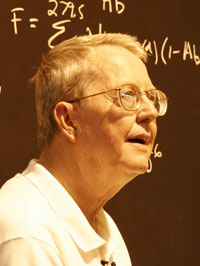Date: 2012-01-14 Time: 07:00 - 09:00 US/Pacific (1 decade 3 years ago)
America/Los Angeles: 2012-01-14 07:00 (DST)
America/New York: 2012-01-14 10:00 (DST)
America/Sao Paulo: 2012-01-14 11:00
Europe/London: 2012-01-14 14:00
Asia/Colombo: 2012-01-14 19:30
Australia/Sydney: 2012-01-15 01:00 (DST)
Where: Online Video Conference
This video conference used Fuzemeeting.
The meeting can be replayed by clicking this link:
https://www.fuzemeeting.com/replay_meeting/fccff073/2254277
Description
A new physical (mechanical) model of our universe called Model Mechanics was formulated in 1995. Model Mechanics posits that all the processes, all the particles and all the forces of nature are the results of absolute motions of the fundamental S-Particles or S-Particle systems in a stationary, structured and elastic medium called the E-Matrix occupying all of space.
Model Mechanics gives rise to a new theory of gravity called Doppler Theory of Gravity (DTG). DTG is compatible with the other forces of nature because all the forces of nature are the results of different state absolute motions of the S-Particles or S-Particle systems in the E-Matrix. In 1995 DTG predicts that gravity at the far reach regions of the universe is repulsive. This prediction agrees with the 1998 discovery that the far reach regions of the universe is in a state of accelerated expansion. The 2011 Nobel Prize was awarded to the discoverers of the accelerating universe. Model Mechanics also gives rise to a new theory of relativity called Improved Relativity Theory (IRT). IRT includes SRT as a subset. However, unlike SRT the equations of IRT are valid in all environments, including gravity. This means that the combination of DTG and IRT can used to replace GRT in cosmology applications.




